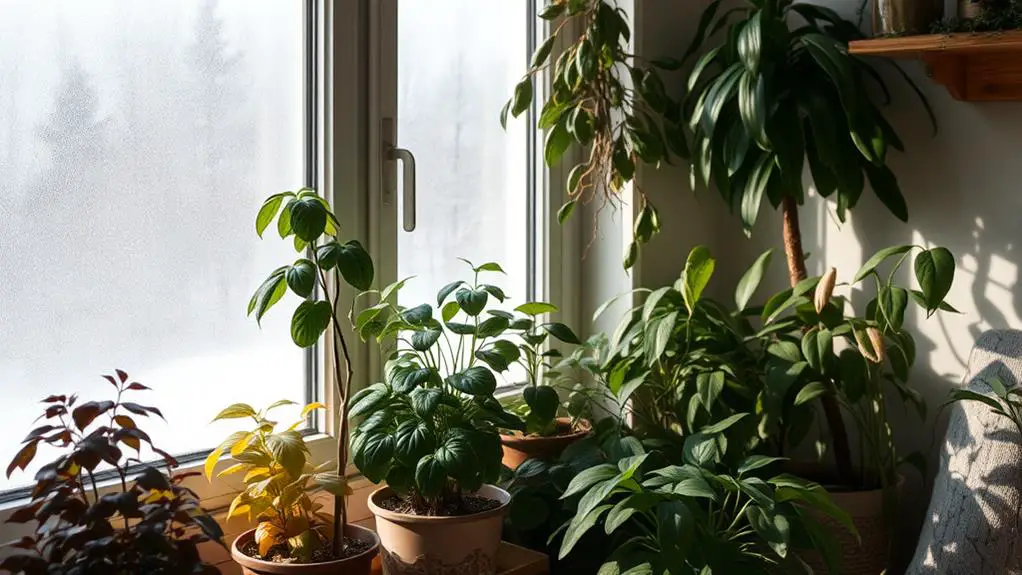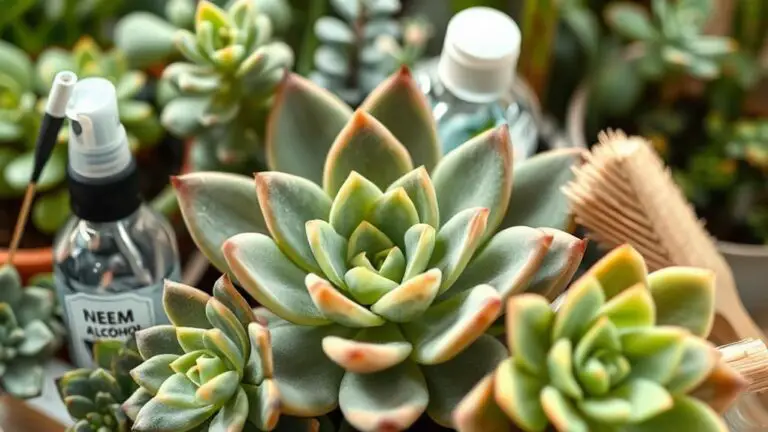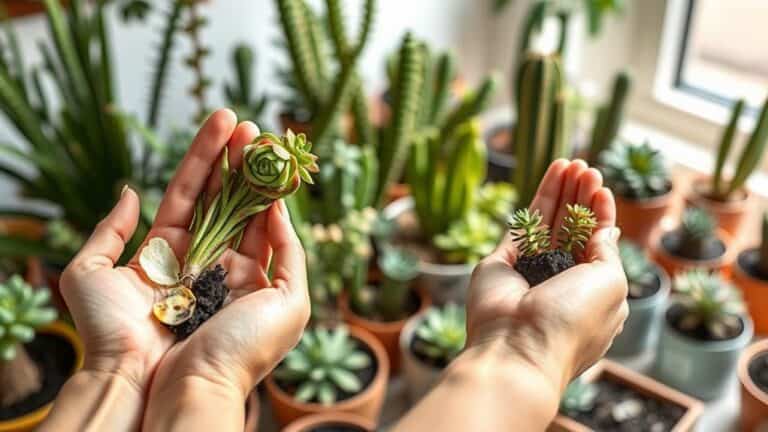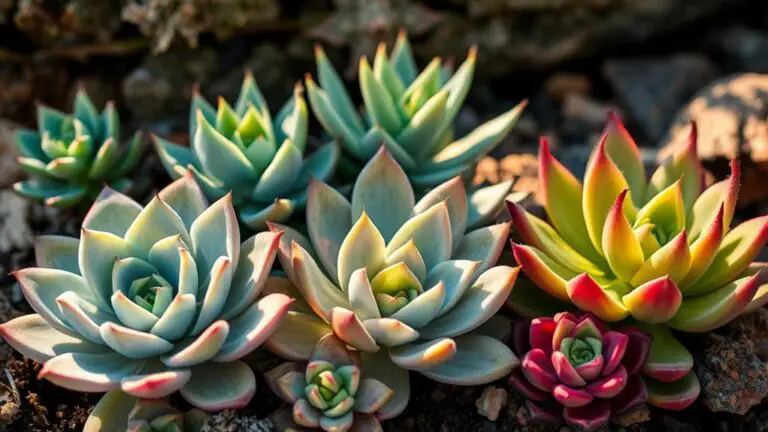Do Houseplants Go Dormant in Winter?
When winter rolls around, you might notice your houseplants looking a bit different—less vibrant, perhaps with fewer leaves. It's easy to wonder if they're dying, but they might just be going dormant. This seasonal change is common due to reduced light, cooler temperatures, and lower humidity. Understanding the signs of dormancy versus distress can help you adjust your care routines to guarantee your plants stay healthy through the colder months. So, how can you tell if your houseplants are merely resting or in trouble? Let's explore what you need to know to keep your indoor garden thriving.
What Is Plant Dormancy?

Plant dormancy is a fascinating period of reduced metabolic activity where growth slows or stops altogether. This happens so plants can conserve energy during unfavorable conditions.
Dormancy is usually triggered by environmental factors like low light levels, cooler temperatures, and reduced humidity, especially in winter months. When days get shorter and light becomes scarce, many indoor plants start to experience a form of dormancy.
You might notice your plants showing signs like leaf drop and slowed growth. This is completely normal. It's their way of adapting to the changing conditions.
During dormancy, plants focus on strengthening their root systems and overall resilience. This helps them survive tough times and be ready to thrive when conditions improve again.
Not all plants enter true dormancy. Some may just slow down their growth or conserve energy without stopping growth entirely.
Whether they're in full dormancy or just taking it easy, your plants are simply responding to the environment. Understanding dormancy helps you provide better care and set realistic expectations for your plant's behavior.
Signs of Dormant Houseplants

Your houseplants' behavior in winter can offer clear indicators that they're going dormant. You might notice a pale appearance, which is a sign that the plant isn't actively growing. Leaf drop is another common indicator of dormancy. If your plant starts losing leaves, it's likely preparing for a rest period.
During this dormancy period, plants use less water, so you'll find the soil stays moist longer than usual. For some species, like caladiums, complete leaf drop can occur. Don't worry, this isn't a sign of trouble but a natural resting phase.
Succulents also show signs of dormancy by slowing their metabolic activity. They conserve energy until conditions improve, using much less water during this time.
While many plants will exhibit these signs, some may still show slight growth, depending on their specific needs and adaptations. Keep an eye out for the overall health of your plant. A noticeable decrease in new growth during winter usually means your plant is in its dormancy period.
Understanding these signs helps you provide the right care. Adjust your watering schedule and be patient. Your plants are simply taking a break, getting ready to thrive again when conditions are right.
Dormancy vs. Dying Plants
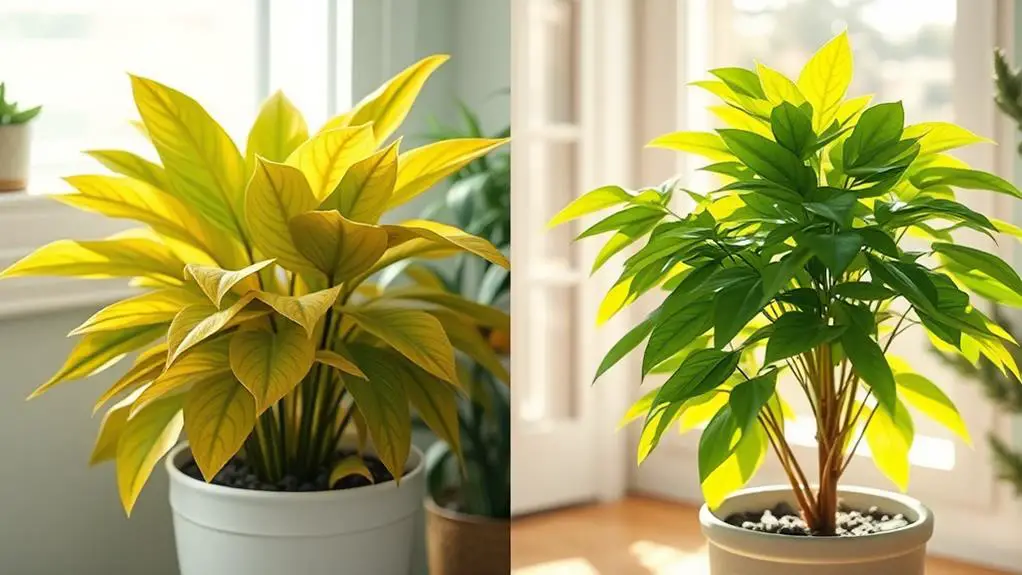
As winter approaches, it's crucial to distinguish between dormancy and a dying plant to provide the right care.
When houseplants go dormant in winter, their growth slows or stops due to environmental factors like drying air and reduced light. However, a dying plant shows signs of irreversible damage.
To determine if your plant is dormant during winter or dying, try these tips:
- Scratch test: Gently scratch the bark. If you see green, moist tissue, your plant is dormant. Brown, hard tissue means it's likely dying.
- Stem flexibility: Dormant plants have flexible stems. If the stem snaps or feels brittle, the plant may be dying.
- Root health: Healthy roots are light-colored and supple. Dark, foul-smelling roots indicate a dying plant.
- Monitor changes: Keep an eye on leaf drop and water usage. Dormant plants will have less water uptake and may lose some leaves, but not excessively.
Environmental Triggers
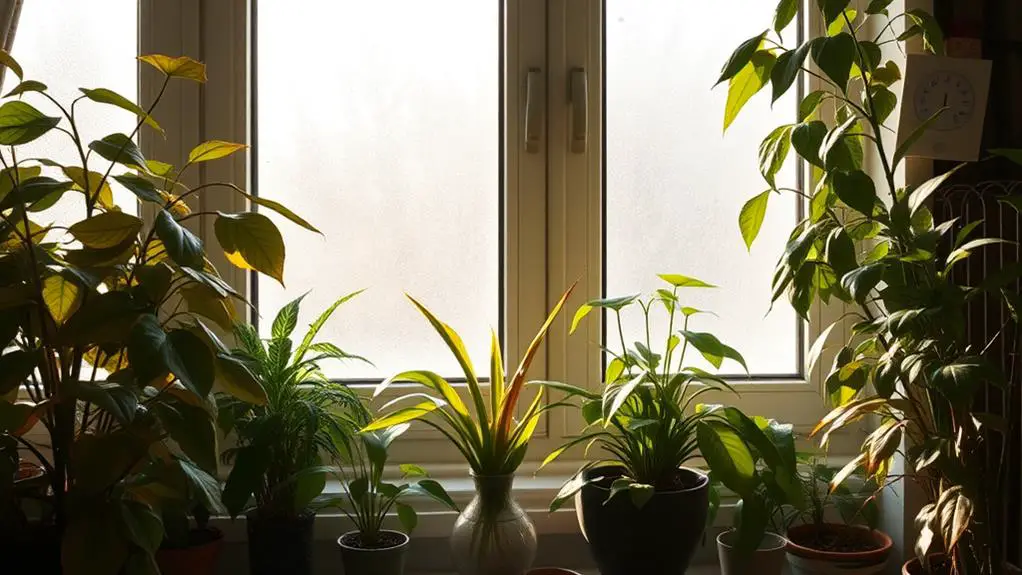
Environmental triggers like shorter daylight hours and dry indoor air can make your houseplants slow down their growth in winter.
When your home's heating system kicks in, it dries out the air, causing your plants to conserve energy.
To help them out, consider using a humidifier and placing them near windows or under grow lights for extra light.
Shorter Daylight Hours
During the winter months, the shorter daylight hours signal houseplants to conserve energy, causing a noticeable slowdown in growth. As the days get shorter, houseplants receive lower light levels, which means they can't produce as much energy. This often leads to changes like leaf drop and less new growth.
Instead of going dormant, many houseplants enter a state of metabolic slowdown to survive. The decreased sunlight triggers your plants to prioritize survival over growth. They conserve energy by reducing their overall activity.
Plants from tropical climates, which don't experience such drastic changes in light, adapt by lowering their energy expenditure rather than entering true dormancy.
To help your houseplants during this time, consider the following tips:
- Provide adequate light: Use natural or artificial light to guarantee your plants get enough illumination.
- Monitor leaf drop: It's normal for some leaves to fall. Don't worry too much if it happens.
- Reduce watering: With slower growth, plants need less water.
- Check for stress: Keep an eye on your plants for signs of stress and adjust care as needed.
Indoor Air Dryness
Winter's indoor air can become quite dry, primarily due to heating systems that greatly lower humidity levels, often dropping below 30% in many households. This dry air can stress your indoor plants, especially those from humid environments, causing leaf drop and slower growth. These conditions can push plants into a dormancy-like state.
To help your plants thrive, it is crucial to increase humidity. You can use humidifiers or pebble trays to add moisture to the air. Plants like ferns and tropical species need higher humidity to survive during winter.
Here's a handy table to illustrate some solutions:
| Problem | Solution |
|---|---|
| Dry Air | Use a humidifier |
| Leaf Drop | Increase humidity |
| Faster Evaporation | Monitor soil moisture |
Another tip is to regularly check your plant's soil moisture. Dry air speeds up evaporation, meaning you might need to adjust your watering routine. Grow lights can also help by providing the necessary light when natural sunlight is scarce.
Understanding these factors will help guarantee your indoor plants stay healthy and happy all winter long. Keep an eye on humidity and make small adjustments to create the best environment for your green friends.
Winter Care Tips
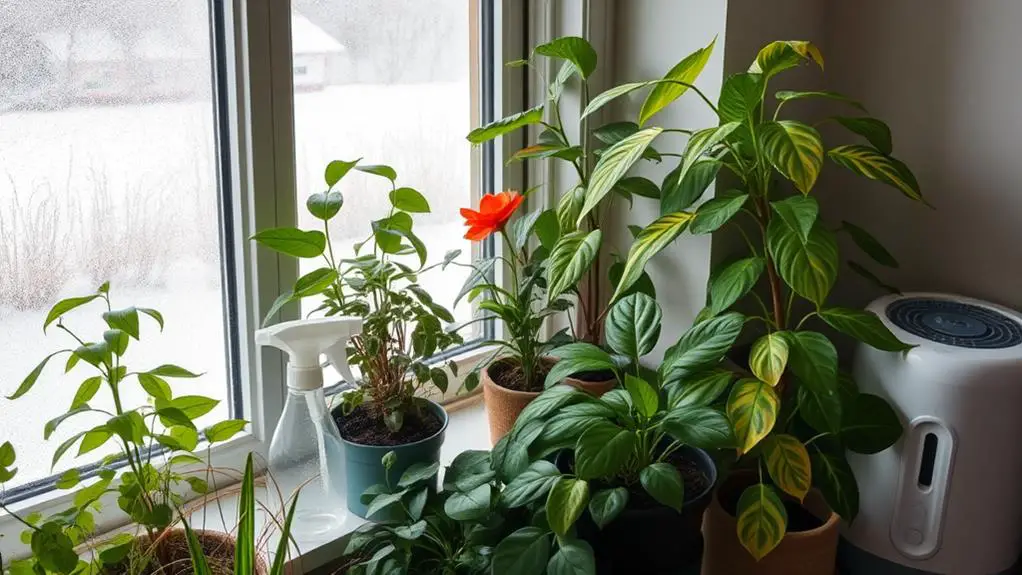
As the days grow shorter and indoor conditions change, it's crucial to adjust your care routine to guarantee your houseplants thrive through the winter.
During the winter months, house plants often experience a slowdown in growth due to reduced light conditions and lower humidity, entering a dormancy-like phase. To help them through this period, you'll need to make a few changes in their care.
First, closely monitor soil moisture. Since plants are growing slower, they don't need as much water. Overwatering can lead to root rot, so check the soil before watering.
Second, avoid fertilizing your houseplants during winter. They don't need additional nutrients until their growth picks up again in spring.
Here are some tips to make sure your plants stay healthy:
- Water less frequently: Let the top inch of soil dry out before watering.
- Use a humidifier or pebble tray: These can help maintain humidity levels in your home.
- Move plants away from drafts: Cold drafts from windows or doors can stress your plants.
- Rotate plants weekly: This ensures all sides get some light, even if it's less intense.
Adjusting Light and Humidity
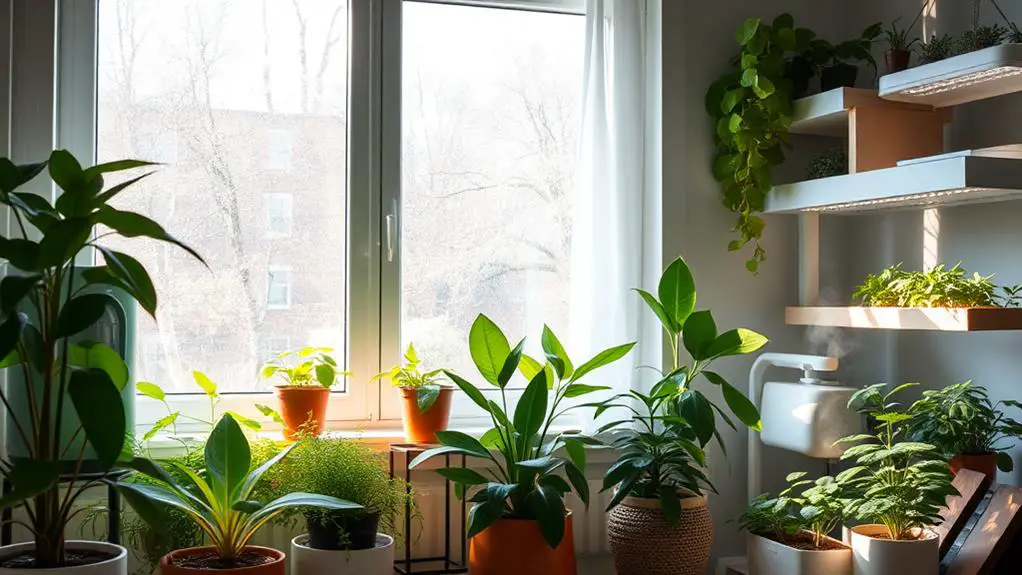
During winter, your houseplants will need extra light and humidity to stay healthy.
Using grow lights can make up for shorter days, while humidifiers or pebble trays can help maintain moisture levels.
Don't forget to place your plants near windows to maximize natural light and consider reflective surfaces to boost their light exposure.
Utilizing Grow Lights
Grow lights are an essential tool for maintaining healthy houseplants during the winter months when natural daylight is scarce. Without enough light, your plants might go dormant, showing less growth and struggling to thrive.
By using grow lights, you can provide the illumination they need to keep putting out new growth.
Here are some key tips for utilizing grow lights effectively:
- Positioning: Place your grow lights 12-24 inches above your plants to mimic the natural sunlight they need for photosynthesis.
- Timing: Use automatic timers to guarantee your plants get consistent light for 12-16 hours a day, which closely resembles their natural environment.
- Light Spectrum: Choose full-spectrum LED grow lights to provide the necessary wavelengths for both vegetative growth and flowering.
- Humidity: Grow lights can help counteract the effects of reduced humidity in winter by providing better light exposure, thereby preventing issues like leaf drop and stunted growth.
Increasing Air Moisture
When winter rolls around, increasing air moisture becomes essential for the well-being of your houseplants. With heating systems making the air dry, your plants can suffer from leaf drop and stress. To help them out, you should focus on boosting the humidity around them.
One way to do this is by using a humidifier in the room. It's a simple and effective method to raise moisture levels, especially for plants that love humid environments.
If you don't have a humidifier, try placing pebble trays filled with water beneath your plant pots. This setup helps maintain localized humidity without overwatering.
Another trick is to group your plants together. When they're close, they create a microclimate with increased humidity from their combined transpiration. It's like a mini jungle in your home!
Besides humidity, light is also vital. Winter means less natural light, so consider using grow lights. They provide the bright, indirect light many houseplant species need to avoid going dormant.
Proper Watering Techniques
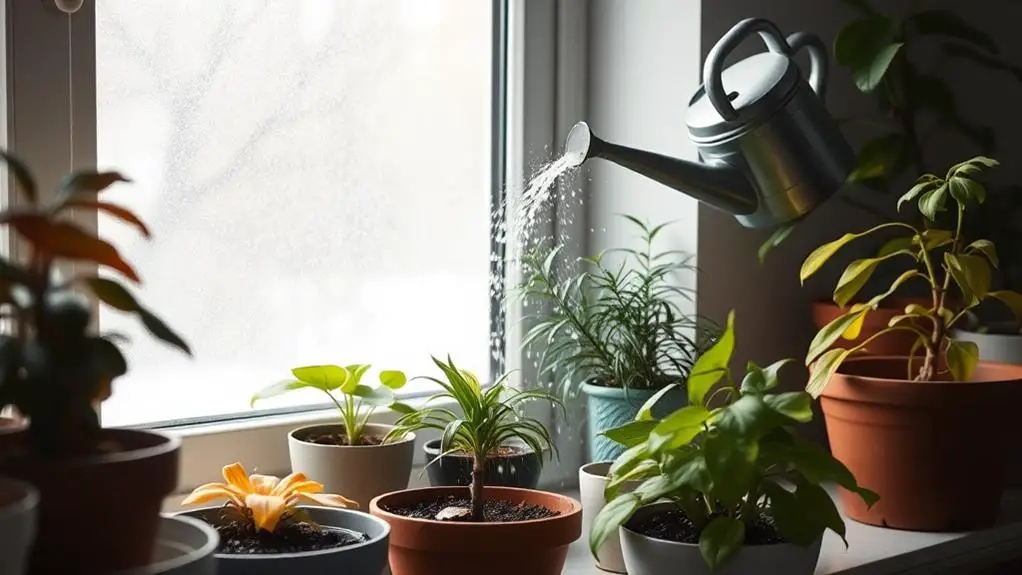
To keep your houseplants healthy during the winter months, adjusting your watering techniques is crucial. During this time, many houseplants enter a dormant phase, slowing their growth due to low light conditions.
You'll need to reduce your watering frequency to match this slower pace.
First, check the soil moisture by inserting your finger about an inch deep. If it feels dry, provide a small amount of water, but avoid overwatering. Overwatering is a common issue in the winter and can lead to root rot.
Here's a helpful checklist to guide you:
- Monitor Soil Moisture: Regularly check if the soil is dry before watering.
- Drainage Matters: Confirm pots have proper drainage holes to prevent water accumulation.
- Healthy Roots: Watch for signs of root rot; healthy roots are light-colored and supple.
- Seasonal Adjustment: Water minimally from late September to March, aligning with their natural dormant phase.
Repotting During Winter
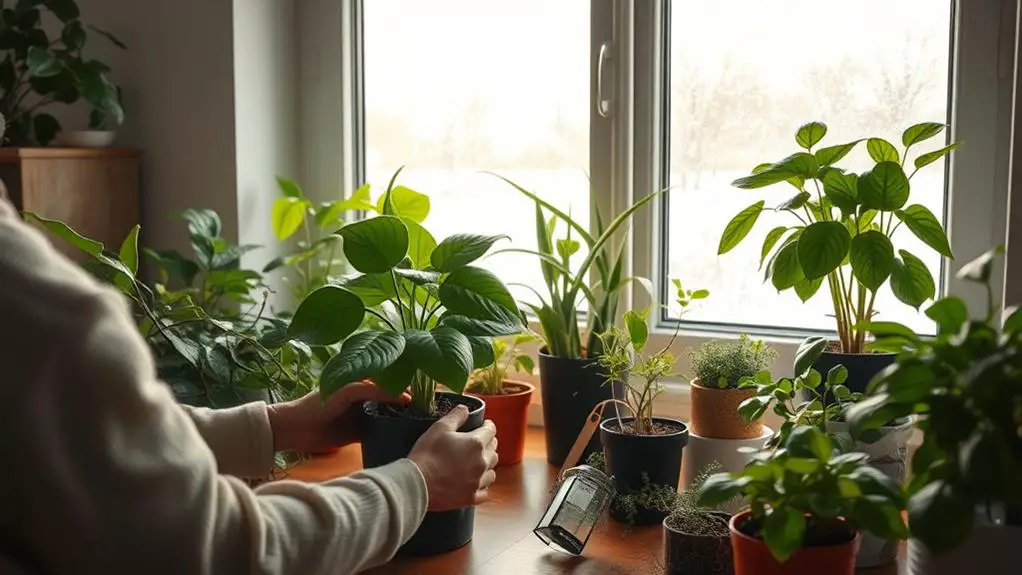
While adjusting your watering techniques is important, repotting during winter is generally not recommended. During winter, houseplants often enter a dormant phase, which means their growth slows down. Repotting at this time can stress your plants because the combination of low light and cooler temperatures makes it harder for them to recover.
Only consider repotting if it's absolutely necessary, like if there's root rot due to overwatering. In such cases, your plants need immediate help and waiting until spring isn't an option.
However, if you must repot during winter, choose a pot that's only slightly larger than the current one. This minimizes the stress on your plant's roots.
Ensure the new potting mix has good drainage and is suitable for your specific type of houseplant. This helps maintain the plant's health through the colder months.
Most houseplants prefer to be repotted in spring when they're actively growing and can handle the stress better. By waiting until then, your plants will be in a better position to thrive.
Expert Recommendations
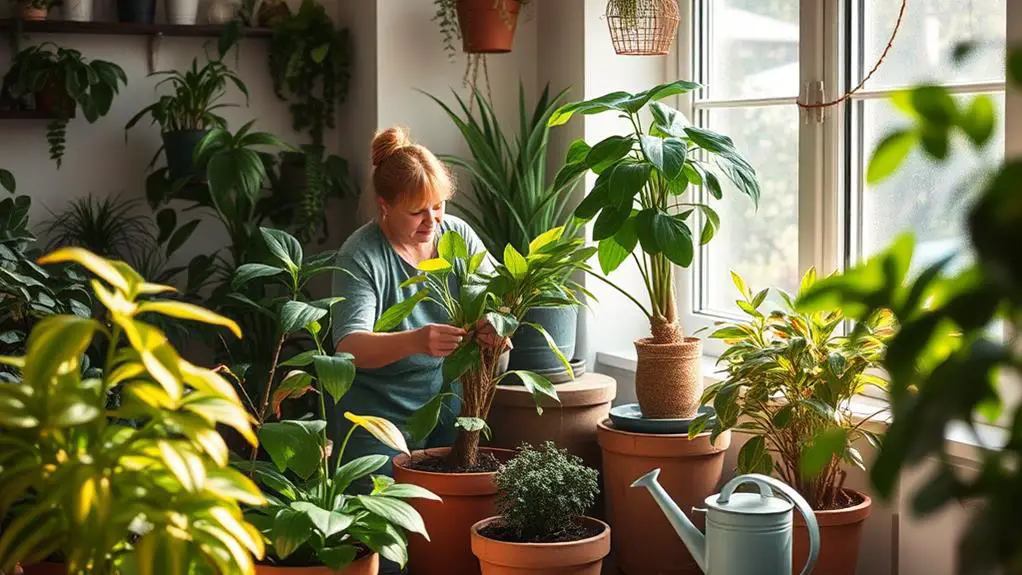
Understanding expert recommendations can greatly enhance your ability to care for houseplants during winter. Justin Hancock stresses that knowing how your houseplants behave when the days get shorter is key. Many won't go dormant but will slow their growth, and adjusting your care routine accordingly is essential.
To keep your plants healthy during winter, experts suggest:
- Monitor environmental factors: Regularly check humidity and light levels. Your plants still need good conditions even when they're not actively growing.
- Reduce watering frequency: Overwatering can cause root rot. Since your plants aren't growing as much, they need less water.
- Increase humidity: Heating systems can dry out the air. Using humidifiers or pebble trays can help maintain the moisture your plants need.
- Supplement natural light: Shorter days mean less sunlight. Consider using artificial lights to provide the light your plants still need for photosynthesis.
Frequently Asked Questions
Do Indoor Plants Stop Growing in Winter?
No, indoor plants don't completely stop growing in winter, but they do slow down. You'll notice less new leaf production and occasional leaf drop. To help them, use grow lights and maintain consistent humidity and temperature.
Do You Water Plants When They Are Dormant?
Yes, you should water dormant plants, but only minimally. Check the soil moisture; if the top inch is dry, water sparingly. Overwatering can cause root rot since the plants absorb less moisture during dormancy.
Is It Normal for Houseplants to Lose Leaves in Winter?
Yes, it's normal for houseplants to lose leaves in winter. They respond to reduced light and humidity by shedding leaves to conserve energy. Guarantee proper care by monitoring soil moisture and adjusting conditions for recovery in spring.
How to Bring a Plant Out of Dormancy?
To bring a plant out of dormancy, gradually increase its light exposure, guarantee stable warmth, and start watering cautiously. Fertilize with a diluted, balanced mix in early spring. Monitor for new growth to confirm successful awakening.
Conclusion
In winter, your houseplants might go dormant, but don't worry. With some simple adjustments like monitoring soil moisture, providing enough light, and maintaining humidity, you can help them thrive. Remember, dormancy is normal and doesn't mean your plant is dying. By following these winter care tips, you'll guarantee your plants stay healthy and ready to grow again in spring. Keep an eye on their needs, and you'll be a successful plant parent through every season!

